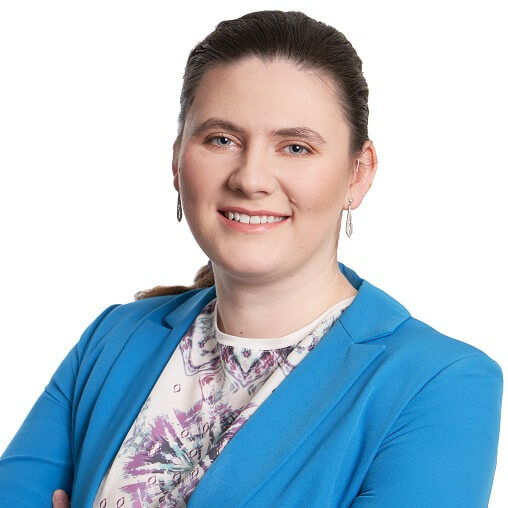The IP Day is a day to celebrate intellectual property. As Lisa Jorgenson of the World Intellectual Property Organization (WIPO) announced, this year it will be dedicated to celebrating women’s innovation, creativity and intellectual contribution to technological development. Although they make up half of the population, women do not benefit as much from intellectual property as men do. Today we want to present the activities of the women who, with their hard work, ingenuity and perseverance, have achieved success and, despite numerous obstacles, are an inspiration for the next generations.
Get to know 5 extraordinary Polish women: enterprising inventors and scientists whose ideas may soon revolutionize our everyday lives and help us plan a better future.
A Brief Look into the Future
First, let’s use our imagination a bit. It’s Saturday morning. You get up, put the electric kettle on [1], turn on the TV [2] to select the next episode of your favourite show on a streaming platform [3]. In the kitchen, you unpack vegetables from plastic wrap [4] for breakfast, and you take out quality meat [5] from the freezer for dinner. All quick and easy? Of course, it is! And did you even realize that you have just used our heroines’ inventions? Let’s take a closer look at them.
1. Olga Malinkiewicz, PhD – affordable electricity from solar energy
The electric kettle needs electricity to operate. Wouldn’t it be great if the electricity came from the sun and power bills did not drain your pockets? Such an invention was developed by Olga Malinkiewicz, PhD, a co-founder of and Chief Technology Officer at Saule. She has devised a cheap method for producing printed perovskite solar cells, which functions in the legal domain under the title “A film-forming composition and a method for manufacturing a photoactive film.” Since 3 July 2019, the invention has been protected by European Patent No. EP3227394, which affords legal protection in all the 32 countries indicated.
Although perovskite cells are the most famous invention developed by Olga Malinkiewicz, she is also a co-inventor mentioned in other applications and patents, e.g., applications No.
P.429454 – a method for obtaining organic iodides, a perovskite-forming composition with organic iodide obtained with this method and a photovoltaic cell with a perovskite layer made from this composition,
P.436654 – a substrate with a biocidal coating and a method for producing the biocidal coating on the substrate; or protective right Pat.233211 – an optoelectronic foil and a method for producing the optoelectronic foil.
What is patent protection for? First of all, it protects the interests of the inventor of a given solution, provides the inventor with the opportunity to commercialize the invention and make profits from it. This type of protection is granted for a maximum of 20 years, in the territory of one or multiple countries. The patent protects the inventor against unfair actions of his or her competitors, such as copying, and in the case of an infringement, it constitutes a basis for a quick resolution of the dispute in favour of the inventor.
2. Prof. Elżbieta Frąckowiak – electricity storage
We need electricity around the clock, regardless of the weather. Therefore, the energy generated with the use of perovskite cells must be stored somewhere. This issue is dealt with by Prof. Elżbieta Frąckowiak, who for many years has been conducting research on nanomaterials and composites which would enable efficient operation of energy-storing supercapacitors. She works for the Institute of Chemistry and Technical Electrochemistry at the Faculty of Chemical Technology of the Poznan University of Technology, where she conducts research on lithium-ion cells and fuel cells.
She is a co-inventor of European Patent EP184697, whose protection, however, expired due to the failure to pay applicable fees, as well as numerous applications and patents still in force in the territory of the Republic of Poland, e.g.:
Pat.238271 – a method for modifying activated carbon for electrochemical capacitor electrodes,
Pat.238782 – a hybrid electrochemical capacitor operating in an aqueous electrolyte,
Pat.238545 – an electrochemical capacitor,
Pat.238544 – an electrochemical capacitor with a solid electrolyte.
Most of protective rights to her inventions have expired,e.g.:
Pat.215046 – an electrochemical capacitor operating in an iodide solution,
Pat.213083 – an electrochemical capacitor operating in an electrolyte solution with the addition of a surfactant;
Pat.225412 – a reversible electrochemical <C>Hl NiOOH cell.
What does that mean? There may be several reasons for a patent to expire. For example, no fee has been paid for further protection or patent protection have expired by law (i.e., after 20 years from the filing of the invention). Subsequently, such inventions enter the public domain and can be freely used for the benefit of humanity. This helps balance the interests of the inventor by providing him or her with a monopoly for 20 years and those of the society by providing it with access to the outcomes of technological development accumulated over time. It is less common that the right holder, i.e., the holder of the protective right, relinquishes this right, or that there is no sufficient material required for a specific invention to be used.
3. Marta Karczewicz, PhD – super quality of image and sound
As we already have enough green energy stored in chemical supercapacitors to use electricity without worrying, we deserve some entertainment. Another episode of a new show is being displayed on the TV screen with the quality of the image which was unthinkable 10 or 15 years ago. And we owe this to Marta Karczewicz, PhD, who for many years has worked on the quality of audio and video data transmission. Her solutions are used in most streaming platforms or video meeting applications. With her team at Qualcomm, she has developed numerous solutions and patented over 700 of them! It is thanks to her work that we can watch TV shows in 4k resolution, and soon even 8k may be possible!
Probably due to the prevalence of such inventions in practice, they are filed under the Patent Cooperation Treaty (PCT), i.e., as international patent applications. The PCT track allows you to obtain protection in multiple countries at the same time. Such a track was used by Marta Karczewicz, PhD, in the case of, among others:
EP2147556 – mode uniformity signaling for intra-coding,
EP2679009 – multi-metric filtering,
EP2319243 – filtering video data using a plurality of filters.
However, many of her inventions are not protected in the territory of Poland. Why is that? When we look at the international (PCT) procedure, whose decisive advantage is the possibility to obtain protection in many countries at the same time, we will see that it requires a number of conditions to be met. From the moment a protection right is granted by the EPO, the right holder has three months to validate the patent in the territory indicated. In several cases, Marta Karczewicz, PhD, was deprived of legal protection in Poland due to the failure to have a specification translated or to complete formalities.
4. Aneta Tor-Świątek, PhD – films, polymers, plastics
With the kettle already boiling and the TV pleasantly humming in the background, it is time to prepare breakfast. If we plan to make, for example, a salad, maybe we will come across the invention of our next heroine, Aneta Tor-Świątek, PhD, who in her scientific work focuses on plastics, polymers, porous materials and biopolymers, i.e., films intended to come into contact with food. For developing a method for producing microporous film (thinner, more efficient to produce, easier to recycle and with bactericidal properties), she received a golden medal and a special award at the Korea International Women’s Invention Exposition!
Aneta Tor-Świątek, PhD, is an inventor of many inventions that were or are still protected by patent law, e.g.:
Pat.221235 – a thermoplastic porous pipe,
Pat.216419 – thin-walled porous coating,
Pat.229811 – a two-layer polymer-wood section and a method of its production,
Pat.228302 – a method for producing a porous material,
Pat.227069 – a method for producing a polymer composition,
Pat.241756 – a method for producing a three-layer pipe.
The invention awarded in Korea has already been filed with the Patent Office of the Republic of Poland as P.442419 – a method for producing microporous film. The Office will now consider whether the submitted application comprising, among others, a description of the invention disclosing its object and drawings meets the necessary conditions for a protection right to be granted.
There are three main patentability requirements: novelty, an inventive step and industrial applicability of the invention. We keep our fingers crossed that a patent is granted and the product is successfully launched on the market!
5. Krystyna Stecka, PhD Eng
After a healthy breakfast, it’s time to plan your next meal. It can be, for example, quality meat from organic livestock farming. Nowadays, consumers pay more and more attention to the conditions in which livestock live and to the problem of excessive use of antibiotics, which, through consumption of meat, eventually reach humans. And these issues are, among other things, focus of research work conducted by Krystyna Stecka, PhD Eng, Head of the Department of Fermentation Technology at the Institute of Agricultural and Food Biotechnology in Warsaw. She carriers out a wide range of activities related to lactic acid fermentation bacteria, the use of yeast in alcohol production and the use of probiotics to improve the welfare of breeding animals by including probiotics in their feed.
Over the years, Krystyna Stecka, PhD Eng, has created many solutions that have been provided with patent protection, and the use of which has had a positive impact on the food and agricultural industry, e.g.,
Pat.187973 – a method for obtaining a yeast protein hydrolysate,
Pat.190234 – a yeast biopreparation for animals and a method for producing the yeast biopreparation for animals,
Pat.202039 – a method for producing rectified spirit,
Pat.202418 – a method for producing fruit in alcohol and the fruit in alcohol,
Pat.217703 – a bacterial starter culture for pickling cucumbers.
The IP Day – a celebration of creativity!
Invention are not only machines, but they also include technical, chemical, biotechnological or computer solutions. It is extremely edifying that scientists more and more often seek legal protection for their intellectual property, and some develop their solutions and turn them into a business. The women presented today may differ as regards scientific fields they are interested in, scale of their activities or age, but what they have in common is passion, commitment and vast specialist knowledge. And the intellectual property law is designed to serve such creative, innovative and ingenious individuals. We wish everyone who comes into contact with them, from inventors themselves, through patent attorneys and experts, to the employees of the Polish Patent Office, EPO and WIPO, all the best on the occasion of the IP Day. May there be more and more interesting solutions in all the fields of science!



